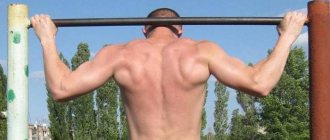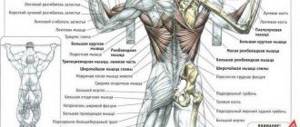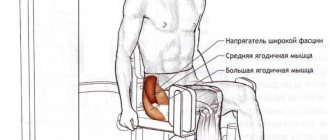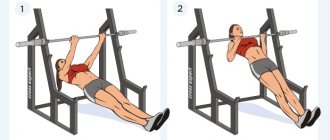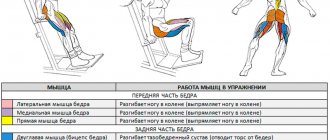Wide-grip chest pull-ups
Main accent: paired round, top of lats, trapezoidal.
Execution: grab the bar with a grip approximately equal to the grip in the bench press with a barbell, while clasping the projectile with your thumbs from above - this better stretches the latissimus dorsi muscles. Without straining your biceps and squeezing your shoulder blades, pull yourself up, trying to touch the bar with the top of your pectoral muscles. Arch your back and look straight up. After pausing a little at the top point, return to the starting position.
Execution technique and main mistakes
Technique:
- Grab the horizontal bar with an overhand grip (palms cover the bar and face outward). Hands are shoulder-width apart.
- Hang on the horizontal bar and from this position begin to lift your body up using the efforts of your back and arm muscles. Remember the correct breathing technique: the effort is always made while exhaling. Rise until your chin is above the horizontal bar.
- From the top point, smoothly lower down until your arms are fully straightened. At the bottom point, extend your arms completely, but do not lock your elbows. They should remain soft. This way you will not take the load off your muscles and will not overstrain your joints.
Errors:
- Incomplete range of motion (incomplete straightening of the arms at the lowest point or incomplete raising of the body, that is, not touching the horizontal bar with the chin at the highest point).
- Rocking the body and using the force of inertia. In this case, the muscles do not receive the required load and the exercise becomes ineffective.
- Unnatural arch in the lower back. This is always dangerous. In all exercises.
- Bringing the shoulders together at the top. The shoulder joint is like a ball-and-socket joint—it has a ball-and-socket shape and provides the greatest range of motion, from rotation to flexion. An unnatural bend in the shoulders leads not only to ligament damage, but sometimes to partial or complete dislocation of the shoulder. Shoulder compression can also cause injury to the cervical vertebrae.
Close-grip pull-ups
Main emphasis: lower lats, biceps.
Execution: grab the bar with a reverse grip, connecting the ribs of your palms together if possible. Hang on straight arms, arch your back and look at your hands. As you pull yourself up, focus on perfectly moving your shoulders back and squeezing your shoulder blades together. As you approach the top point, try to bend your back more and touch the bar with your lower pectoral muscles.
Back muscle training
How attractive are girls with straight posture! How courageous young people look who do not slouch even while doing hard work. In order for our back to always be straight and beautiful, it also needs to be trained. Can exercise with a horizontal bar help with this? Certainly!
When doing pull-ups on the horizontal bar, the following back muscles work primarily:
- Latissimus muscles. To quickly pump them up using a horizontal bar, you should grab it with a wide grip.
- Rhomboid muscle. She will train while performing any exercises with a bar.
- Large round muscles. They are located in the armpit area. They can be trained if, during pull-ups, you try to move your shoulders back and pull your torso towards your elbows.
Pectoral muscles
During training on the horizontal bar, our torso rises to the bar from time to time. During this action, the pectoral muscles will also be involved.
It is known that you can also make your breasts beautiful with the help of exercises with parallel bars. However, we will devote one of the following articles to this topic. After all, now we are talking about how great the benefits of exercises with the crossbar are.
In order to train the chest muscles as much as possible during exercises on the horizontal bar, you should ensure that: - The torso does not sway; — All exercises were performed harmoniously, without any jerks.
Abdominal muscles
This group of muscles usually includes the rectus abdominis muscles, consisting of 6 squares, as well as the oblique and transverse abdominal muscles. All of them are considered the main stabilizers during any physical exercise, including pull-ups.
They help maintain an even posture and a fit appearance while standing and sitting. The abdominal muscles will be trained while performing any active exercises on the horizontal bar.
Neutral grip pull-ups along the bar
Main emphasis: lower lats, serratus and brachialis muscles.
Execution: Grab the bar with one fist in front of the other. Pull yourself up, actively arching your back and trying to touch the bar with your lower pecs. At the top point, move your head away from the horizontal bar - with each repetition, to the other. Change the position of your hands from set to set.
Mass pull-up diagram
When talking about how to gain muscle mass on the horizontal bar, you should clarify that you will need to do different variations of pull-ups and muscle-ups.
To start, focus on pull-ups. This will be a kind of preparation. For example, you can exercise three times a week.
Let's designate training days with numbers:
- Pull-ups with a reverse narrow grip in three approaches for the maximum number of times (but not less than 10 per approach).
- Pull-ups with a wide straight grip on the back, the same amount.
- Pulls with a classic medium grip. We do “unloading”, 3 sets of 10 times.
The last day should be easy so that your muscles do not overwork. Try doing this for a month. In 30 days you will complete approximately 12-13 workouts, then, depending on your results, you can start working on weight.
Yes, you understood correctly, you will need to use weights.
Gradually begin adding additional pounds to your weight. These could be water bottles tied to your waist, a backpack with weight plates, or a classic weight vest. Or maybe you will use leg weights? Your choice.
The training scheme remains the same. On the first and second days, we reduce the number of repetitions in the approach to 6-8. The weight should be such that the last pull-up is difficult for you. The third day is left as a “fasting” day. That is, we work 10 times without weights or with light weights.
We perform all movements slowly, without jerking. If you weigh too many pounds, you won't be able to do all the reps smoothly. You'll have to move in jerks. People with connective tissue defects are at risk of pulling the muscles of the forearm and shoulder. Be aware of these risks and avoid sudden movements.
In parallel with weighted pull-ups, you need to begin to master the power output in different variations. It is better to practice outdoors, since the ceilings prevent you from fully performing exercises indoors.
Exercise on the crossbar regularly, fight laziness - then and only then will you get results. But there is still a nuance on which your progress depends.
There is one problem with exits - if you don't understand the technique, it will be difficult to make them. And it doesn't matter how strong your hands are. Everything will depend on the coordination of the muscles of your body.
Popular errors and problems
Unfortunately, we cannot always achieve results, even when we put in a huge amount of effort. This could be due to several factors such as:
Improper execution of the exercise. You can eat right, exercise every day, work until you lose strength, but if you do the exercises incorrectly, then nothing will help you. It is very important to follow the correct technique and do everything slowly.
Being overweight is a popular problem for many people who want to exercise.
Such a person works out for a long time and diligently, but does not show results, he does not know how to increase the number of pull-ups on the horizontal bar, because everything is frozen in one place.
In this case, you need to lose excess weight, about 7-10 kilograms, and then start exercising again.
Don’t focus your attention on just one exercise, constantly pump up all muscle groups and only then will you see results.
Always warm up your muscles before starting pull-ups. Do a short 5-minute warm-up, this will significantly reduce the likelihood of injuries and sprains.
There is no need to work to failure in the first week, exhausting the body with loads, everything should happen gradually.
It is interesting to know that the world record for pull-ups on the horizontal bar was set by a 70-year-old man from South Korea in 1994. He was able to do 630 pull-ups. To date, no one has been able to surpass this record.
We advise you to keep your personal diary of results, in which you will record your personal record for pull-ups on the horizontal bar in one approach. This will allow you to see your results and give you motivation for further training.
How can a beginner learn to do pull-ups?
If you can't do a single pull-up, there are several options. Using one of them it is much easier to learn how to do pull-ups on the horizontal bar.
- You can use a stool. By standing on it, it is easier to pull yourself up on the horizontal bar. At the top point, you must try to stay in a taut position for three seconds, gradually increasing this figure to seven seconds, and jump to the ground. You need to repeat this 5-7 more times.
- There is another method - belaying with rubber. By tying yourself around the waist with a wide sports rubber band and hanging it high from the horizontal bar, it is easier to return to the highest point of the pull-up. After a week, you will be able to work on the horizontal bar without insurance.
- Beginners perform pull-ups with jerks. This significantly makes the task easier at the first stage, but after five to seven days you need to abandon this help and perform the training according to all the rules.
A month is usually allotted for training. You can use the following table.
How to do pull-ups correctly?
Proper pull-ups are not only about performing this exercise, but also about the number of repetitions performed.
For this, there is a special pull-up pattern on the horizontal bar. You can find it in any thematic Internet source and familiarize yourself with it in detail.
So in the first week you need to do at least 120 pull-ups. Every day, 3 sets of 15 pull-ups. This technique will help strengthen your muscles and prepare them for even greater loads.
Risks of injury
Playing sports does not guarantee your complete safety; there is always a risk of injury. To prevent this you need to follow certain rules.
Always pay attention to the condition of your palms. The appearance of calluses is a signal to stop pulling up for a while.
Give your body time to rest and recover. To make it more comfortable for you to practice, use gloves.
Never make sudden jerks, otherwise you risk straining muscles and breaking bones.
To avoid pain during pull-ups, you need to warm up your muscles.
Do a short 5-minute warm-up to warm up your muscles and minimize the risk of injury.
Motivation
Motivation plays a big role in this matter. If you don't find the motivation to exercise, you won't be able to achieve anything.
First, ask yourself the question, why do I need it and what do I ultimately want to get?
After you have answered yourself, begin to tune in to long and exhausting work in the fight against laziness and your body.
During training, constantly encourage yourself, tell yourself that you can do anything. Listen to appropriate motivating music, read the right literature and never give up.
Also, for additional support, invite a friend to study with you, it’s always easier for two people.
